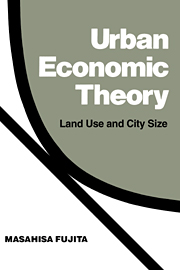Book contents
- Frontmatter
- Contents
- Preface
- 1 Introduction
- Part I Basic theory
- 2 Locational choice of the household
- 3 Equilibrium land use and optimal land use: single household type
- 4 Equilibrium land use and optimal land use: multiple household types
- 5 Urban aggregates and city sizes
- Part II Extensions with externalities
- Appendixes
- References
- Author index
- Subject index
4 - Equilibrium land use and optimal land use: multiple household types
Published online by Cambridge University Press: 23 December 2009
- Frontmatter
- Contents
- Preface
- 1 Introduction
- Part I Basic theory
- 2 Locational choice of the household
- 3 Equilibrium land use and optimal land use: single household type
- 4 Equilibrium land use and optimal land use: multiple household types
- 5 Urban aggregates and city sizes
- Part II Extensions with externalities
- Appendixes
- References
- Author index
- Subject index
Summary
Introduction
In this chapter, we consider the case of multiple household types. The contents of the chapter are parallel to those of the preceding chapter. First, we introduce the concept of well-behaved bid rent functions and lot size functions in order to establish a rigorous mathematical base for the bid rent curve approach. Then in Section 4.3 we go on to define equilibrium land use in the context of the closed-city model under absentee landownership and demonstrate its existence and uniqueness. In Section 4.4 we define optimal land use and show its existence and uniqueness. As in Chapter 3, we use boundary rent curves, taking a graphical approach to the proof of the existence and uniqueness of equilibrium and optimal land use. This also leads to a simple algorithm for the computation of equilibrium and optimal land use. In Section 4.5 we compare equilibrium and optimal land use, and draw the conclusion that the competitive equilibrium is socially efficient. In Section 4.6, we conduct comparative static analyses of equilibrium land use. Again, by using the boundary rent curve approach, we examine the effects of population and income changes on equilibrium land use.
Although our boundary rent curve approach for the existence and uniqueness problem is mathematically simple and intuitively appealing, it requires a strong condition–that the set of bid rent functions involved in the problem can be ordered according to their steepness. Hence, this approach works only for a limited class of problems.
- Type
- Chapter
- Information
- Urban Economic TheoryLand Use and City Size, pp. 97 - 132Publisher: Cambridge University PressPrint publication year: 1989



